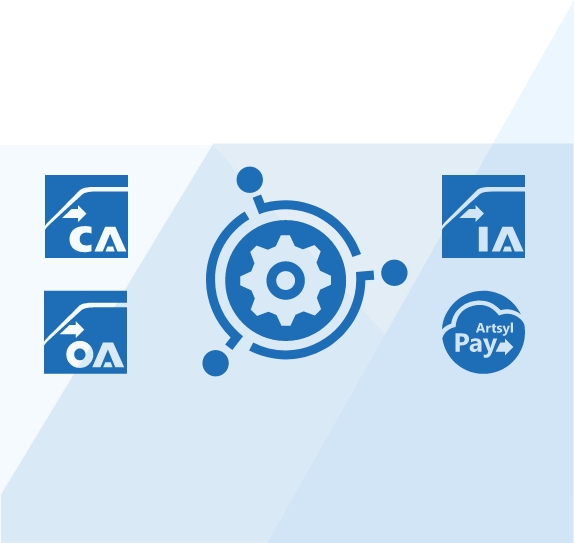With the increasing digitization of data and processes across industries, the power of Optical Character Recognition (OCR) automation has become more important now than ever before. OCR is a technology that can recognize text within an image or document, making it possible for businesses to convert physical documents into digital format for easier handling and more efficient workflow.
The OCR automation enhances the process’s speed and accuracy, saving businesses time and money in the long run, which is important for businesses of all industries and sizes. In this blog post, we’ll explore the benefits of OCR automation in the age of digital transformation.

In seconds, transform paper-based documents and images into editable, searchable, and actionable data.
Use docAlpha to create streamlined workflows and ditch time-consuming manual tasks. Take the leap towards automation now!
What is OCR Technology in a Nutshell?
OCR technology, or Optical Character Recognition technology, is a powerful tool for extracting and translating text from images and scanned documents. It works by analyzing the patterns and shapes of characters and then converting that information into searchable, editable text.
The benefits of OCR technology are clear — it saves time by eliminating the need for manual transcription and opens up new data analysis and management possibilities. Whether scanning a document for personal use or digitizing a large archive for a business or organization, OCR technology is essential for streamlining your workflow and improving your productivity.
Experience OCR at its best with Artsyl docAlpha! Embrace the future of data extraction and document automation. Enhance your organization’s efficiency, eliminate errors, and gain real-time insights from digitized documents. Ready to take your business to the next level?
Book a demo now
How Does OCR Work?
OCR (Optical Character Recognition) automation is a technology that converts different types of documents, such as scanned paper documents, PDF files, or images captured by a digital camera, into machine-readable text data. It is a key component of automation processes that involve extracting information from physical or digital documents and converting it into editable and searchable formats. Here’s how OCR automation works:
- The process begins with capturing documents using a scanner, smartphone camera, or other imaging devices. These documents can be invoices, receipts, forms, contracts, or any text-based content that needs to be digitized.
- Before OCR can accurately extract text from the document, the captured images are pre-processed. This step involves enhancing the image quality by removing noise, adjusting brightness, and improving contrast to optimize the accuracy of OCR results.
- The OCR software analyzes the pre-processed image, identifying patterns and shapes that resemble characters. It then attempts to recognize each character and convert them into machine-readable text.
- The OCR engine matches the identified patterns against a library of known characters and fonts during character recognition. Modern OCR engines utilize machine learning algorithms to continuously improve character recognition accuracy based on the data they process.
- Once the characters are recognized, OCR automation extracts the recognized text. It converts it into an editable and searchable format, such as plain text or a structured data format like XML or CSV.
- After text extraction, post-processing techniques are applied to validate and correct any errors or inaccuracies in the OCR results. This may involve spell-checking, grammar correction, and context-based validation to ensure the extracted text is as accurate as possible.
- Depending on the automation requirements, the OCR-processed data can be integrated into various applications or databases. It can be used in data entry, content indexing, information retrieval, or further processed by other software.
OCR automation has widespread applications in various industries, including finance, healthcare, legal, and administrative tasks, where converting physical documents into digital data is essential for efficient and accurate operations.
Don’t let piles of paperwork slow you down. The advanced OCR functionality of docAlpha allows you to convert paper and image-based documents into digital data goldmines effortlessly. Optimize your processes and make informed decisions like never before!
Book a demo now
What is OCR Automation?
OCR (Optical Character Recognition) technology allows digital devices to scan, analyze and recognize printed and handwritten characters in images. OCR software scans an image, identifies characters and converts them into digital text that can be edited, searched, stored, and shared. OCR has been around for decades, but as technology has advanced, OCR automation has become more effective and ubiquitous.
OCR automation involves utilizing advanced algorithms to process vast amounts of data, eliminating repetitive manual data entry processes and reducing human errors. These automated systems can convert hard-copy documents, invoices, receipts, and forms into a searchable, editable format.
OCR automation technology is particularly useful for businesses that deal with a high volume of paperwork, such as financial institutions, healthcare providers, and government agencies. With OCR automation, businesses can improve operational efficiency, reduce costs, and speed up internal workflows.
OCR Automation and Data Accuracy
Apart from increasing efficiency, OCR automation is also beneficial for data accuracy. Many businesses have recognized that the accuracy of data inputs is essential to the accuracy of the business intelligence derived from it. OCR automation results in cleaner, more reliable data, improved business decision-making, reduced audit risk, and better compliance.
Using OCR Automation in Business
OCR automation has countless applications in businesses across various domains. It can be used to digitize records, streamline manual data entry, automate invoice processing, reduce invoice processing time, increase accuracy, and improve vendor relations.
In the legal sector, OCR automation can quickly scan complex legal documents and extract the necessary information. In the healthcare sector, OCR automation can recognize the text on medical forms, including handwritten notes and help automate the medical billing process.
OCR automation has come a long way over the past couple of decades, as have the efficiency and accuracy of systems. In today’s modern world, businesses have access to OCR automation technology which simplifies and automates data entry, thus making operational processes more efficient, accurate, and cost-effective.
OCR automation is becoming an essential tool for businesses that want to stay ahead of the competition by improving their internal processes, cutting down processing time and improving accuracy.
So, if your business is struggling with manual data entry and wants to leverage the power of automation, OCR automation could be the solution you’re looking for.
Intelligent Process Automation Solution
Related Videos
Benefits of OCR Automation
OCR automation has widespread applications in various industries, including finance, healthcare, legal, and administrative tasks, where converting physical documents into digital data is essential for efficient and accurate operations. Here are some of the tangible benefits:
Improved Efficiency and Accuracy
The automation of OCR allows businesses to process large volumes of data and documents more efficiently and with a higher degree of accuracy than manual data entry. Human errors are reduced, and the OCR technology constantly learns and improves, reducing errors over time. This allows businesses to improve their workflow, allowing employees to focus on more skilled tasks while the OCR automation processes the lower-level tasks.
Cost Savings
OCR automation leads to cost savings in several areas, including reductions in manual data entry labor costs, improvements in efficiency, elimination of physical storage and decreased risk of lost or damaged documents. OCR automation can also improve decision-making as businesses have easier access to important data and can analyze it quickly and efficiently, leading to better-informed decisions.
Improved Customer Experience
OCR automation can also lead to improved customer experience. For example, a bank that uses OCR automation can process loan applications much faster than relying on manual data entry. This means customers can be notified of loan decisions in a much more timely manner, increasing customer satisfaction with the bank’s service.
Improved Compliance
OCR automation can make complying with relevant industry regulations and quality standards easier. For example, in the pharma industry, OCR technology can improve the accuracy of lot codes and expiration dates on product labels, ensuring compliance with regulations.
Improved Data Analytics
OCR automation enables businesses to extract and translate unstructured data into structured, digital data sets that can be easily analyzed using data analytics tools. These digital data sets can then be used to generate insights and help make better business decisions, providing a competitive edge in the market.
OCR reinvented — discover docAlpha’s game-changing technology! Unleash the potential of your documents with intelligent data capture. Eliminate manual data entry, boost accuracy, and accelerate your business operations. Embrace the OCR revolution today!
Book a demo now
How to Get Started with OCR Automation
OCR automation can be a game-changer for businesses because it allows for digitizing physical documents and makes data extraction faster and more accurate. But how do you get started with OCR automation? This section will help guide you through the process.
Evaluate your OCR Needs
Before you start implementing OCR automation, you need to evaluate your needs. Consider the type and volume of documents you need to digitize, the accuracy and speed required for data extraction, and your budget for implementing OCR automation. Understanding your needs will help you choose the right OCR software and tools.
Choose the Right OCR software
There are many OCR software options available, both free and paid. While free OCR software may seem attractive, it often has restrictions and limitations. Paid OCR software offers more advanced features and can handle more documents. Some popular options include Adobe Acrobat DC, ABBYY FlexiCapture, and Artsyl docAlpha where OCR is built-in by default.
Prepare Your Documents
Before scanning your physical documents, you must prepare them for OCR. This includes ensuring that they are clean, straight, and unmarked. OCR software depends on high-quality scans, so the documents are not folded or creased. If necessary, use document preparation software like ScanTailor to enhance the quality of the document images.
Test and Train your OCR Software
Once you have chosen your OCR software and prepared your documents, you need to test and train the software. OCR software can make mistakes, so training it to recognize characters and words accurately is essential. Testing and fine-tuning the OCR software will ensure it works accurately and efficiently for your needs.
Integrate OCR Automation into Your Workflow
Once you have tested and trained your OCR software, you need to integrate it into your workflow to reap the benefits of automation. Depending on your chosen software, it may be possible to automate the data extraction process entirely. You can integrate OCR software with content management systems or data analytics tools to further streamline your workflow.
OCR automation can be a powerful tool for businesses looking to digitize their physical documents and increase data extraction efficiency. With these steps, you can effectively digitize your documents, streamline your workflow, and enhance efficiency and accuracy.
Make your documents come alive with docAlpha’s OCR magic! Experience the transformation from static documents to dynamic data. Empower your team to focus on high-value tasks by automating document processing. See the magic of OCR in action!
Book a demo now
Final Thoughts: Why OCR Automation is So Beneficial
OCR automation is an essential tool for many businesses undergoing digital transformation. The benefits of OCR automation include improved efficiency, cost savings, improved customer experience, compliance, and improved data analytics. By investing in OCR automation, businesses can streamline processes, eliminate manual data entry, improve decision-making, and gain a competitive edge.
The key is to choose the right OCR automation solution for your business needs and to invest in a digital transformation strategy that promotes the use of OCR automation across multiple departments. With OCR automation, businesses can truly leverage the power of digitization and excel in today’s digital age.



 OCR: What Optical Character Recognition Is?
OCR: What Optical Character Recognition Is? Exploring the Benefits of OCR Technology Across Diverse Business Processes
Exploring the Benefits of OCR Technology Across Diverse Business Processes How to Use OCR Software for PDFs and Other File Formats
How to Use OCR Software for PDFs and Other File Formats OCR Image to Text Conversion: What is It?
OCR Image to Text Conversion: What is It? PDF OCR Conversion: Step-by-Step
PDF OCR Conversion: Step-by-Step Data Extraction with OCR: Extracting Data from Invoices, Forms, Receipts
Data Extraction with OCR: Extracting Data from Invoices, Forms, Receipts
